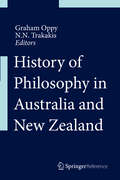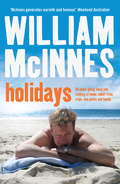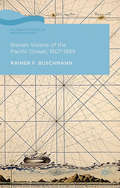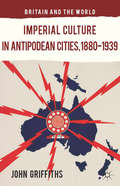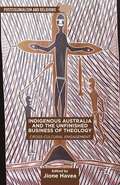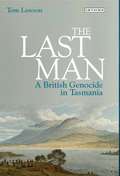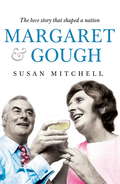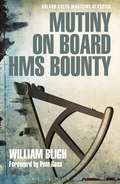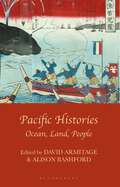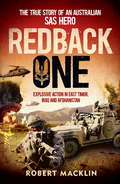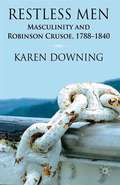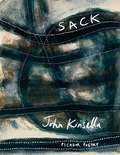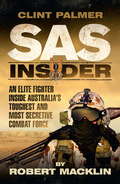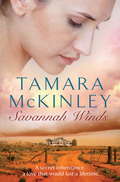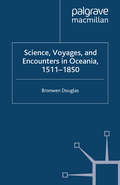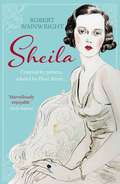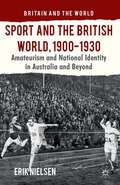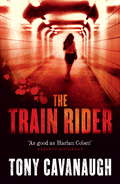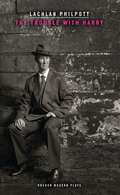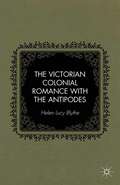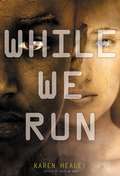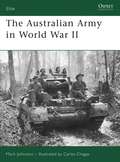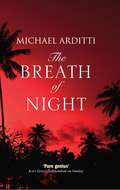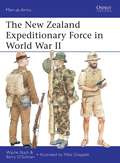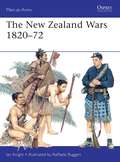- Table View
- List View
Holidays: All About Going Away And Staying At Home, About Train Trips, Lion Parks And Family
by William McInnesFrom bestselling author William McInnes, a book about the languid, unending holidays of summer; it's about going away and staying at home, about sunburn, seagulls, family and friends.Remember those long, languid holidays when the only decisions to be made were what to pack in the Esky and who should get the front seat on the drive to the beach?Let William McInnes reignite your nostalgia for holidays past, and give you a taste of the boundless opportunities that await in holidays to come in this book about our love affair with life away from the everyday.This book will take you back to the holidays you had as a kid and remind you of the ones you've had with your own family or friends or even the ones where you've flown solo.Holidays are the runway to possibilities - a romantic sunset, the spare seat at breakfast being taken by an attractive stranger, a miraculous airline upgrade - or missing bags, unfortunate rashes and wrong turns that lead to places you definitely did not intend to go. Whether you are away from home and somewhere exotic or just in your own backyard on a lilo in an above-ground pool, whatever happens, you know that life is sweet because you're on HOLIDAYS.**Includes a bonus extract from William's hilarious and heartwarming memoir Fatherhood**"McInnes is a natural storyteller . . ." - Sun Herald, Sydney"McInnes enjoys a quirky love affair with the quintessential Australian holiday" - Brisbane News"Proves that the journey is just as agreeable as the destination" - Sunday Age". . . full of beautifully crafted childhood reminiscences and anecdotes" - Sunday Examiner"McInnes is a wonderfully engaging writer - witty and warm and a master of a good yarn. If your holidays aer a way off, curl up with William and he'll take you away" - Adelaide Advertiser
Iberian Visions of the Pacific Ocean, 1507-1899 (Palgrave Studies in Pacific History)
by R. BuschmannIn this work, Buschmann incorporates neglected Spanish visions into the European perceptions of the emerging Pacific world. The book argues that Spanish diplomats and intellectuals attempted to create an intellectual link between the Americas and the Pacific Ocean.
Imperial Culture in Antipodean Cities, 1880-1939 (Britain and the World)
by J. GriffithsDrawing on a wealth of primary and secondary sources, this book explores how far imperial culture penetrated antipodean city institutions. It argues that far from imperial saturation, the city 'Down Under' was remarkably untouched by the Empire.
Indigenous Australia and the Unfinished Business of Theology: Cross-Cultural Engagement (Postcolonialism and Religions)
by Jione HaveaThis book engages a complex subject that mainline theologies avoid, Indigenous Australia. The heritages, wisdoms and dreams of Indigenous Australians are tormented by the discriminating mindsets and colonialist practices of non-Indigenous peoples. This book gives special attention to the torments due to the arrival and development of the church.
The Last Man: A British Genocide in Tasmania
by Tom LawsonLittle more than seventy years after the British settled Van Diemen's Land (later Tasmania) in 1803, its indigenous population had been virtually wiped out. Yet this genocide - one of the earliest of the modern era - is virtually forgotten in Britain today. The Last Man is the first book specifically to explore the role of the British government and wider society in the destruction of the Aboriginal Tasmanians. Although the introduction of European diseases undoubtedly contributed to the decline of the indigenous population, Tom Lawson shows that Britain supported what was effectively the ethnic cleansing of Tasmania - particularly in the period of martial law in 1828-1832. He also illustrates the ways in which the destruction of indigenous Tasmanians was reflected in British culture - both at the time and since - and how it came to play a key part in forging particular versions of British imperial identity. The Last Man provides the first comprehensive picture of Britain's role in the destruction of the Tasmanian Aboriginal population.
Margaret & Gough: The love story that shaped a nation
by Susan MitchellThe Whitlams' wasn't just a love story - it was a dynamic and enduring partnership that shaped our nation.This is the compelling story of former Prime Minister Gough Whitlam, his wife Margaret and their 70-year relationship – personal and political, private and public. It is a story of how two extraordinary people, side by side, led the Australian nation into an exciting and turbulent new era.Gough had no small talk, Margaret had the gift of easy conversation. He was often ill-at-ease in company and preferred his books. She was warm, inclusive and jollied him along. He had a vicious tongue and a quick temper. She always tried to see the best in people. He knew everything about the ideology, history and heroes of the Labor movement. She trusted her instincts. They saw each other as equals and never hesitated to express their different viewpoints. He may have passed the laws that changed the nation, but she made it possible.This is a story of love, respect, struggle, success, failure, disappointment and resilience. It was the strength and endurance of this remarkable relationship that helped change our nation politically, culturally and socially. Neither Gough nor Margaret would have developed into what each became without the influence of the other. Through every major political change, every election campaign, every triumph and every loss, they stood together.Margaret and Gough takes us inside a partnership where the political was always personal and the personal was always political.'Mitchell succeeds in weaving together their lives against a backdrop of Gough's political career ... a fine dual biography' - The Australian'This sweeping, slightly idealised overview of their love, with a bit of political history thrown into the mix, is a lesson in commitment' - Daily Telegraph'Read about Gough the man who read romantic poems from Keats and Shelley to his new wife Margaret on their honeymoon in 1942' - Sunday Territorian
Mutiny On Board HMS Bounty (Great Illustrated Classics #Vol. 19)
by William BlighOn 28th April 1789 a small and unremarkable merchant vessel became one of the most famous ships in maritime history. HMS Bounty was under the command of 34-year-old Lieutenant William Bligh, an inexperienced commander who lacked the respect of a crew attracted to the promise of an easy life in a Tahitian paradise.Fletcher Christian led half the crew in mutiny against Bligh and after overpowering all resistance, they cast their deposed captain adrift along with those still loyal to him. Luckily for Bligh, his skills as a navigator were better than his skills as a captain and he managed to sail the 23ft boat 3,618 nautical miles to Timor in the Dutch East Indies with no chart or compass, and only a quadrant and a pocket watch for navigation. On returning to England he reported what had happened, and the Royal Navy hunted down and captured most of the mutineers.However, this is only half the story – William Bligh's version. The captured mutineers went on trial and their testimonies give a much less heroic portrait of their former captain, accusing him of unduly harsh treatment. Fletcher Christian's older brother Edward, a judge, oversaw a more balanced account of the mutiny. Of the mutineers who returned to England, only three were hanged; four were acquitted and three pardoned.This book gives the fullest version of the mutiny, allowing Bligh's account to sit alongside those of his detractors. The discrepancies are fascinating, and allow us to make up our own minds about this infamous mutiny.Also includes an exclusive Foreword by former World Sailor of the Year Pete Goss, who offers a unique perspective on the trials and tribulations of the Bounty's crew, whether castaway or mutineer.
Pacific Histories: Ocean, Land, People
by David Armitage Alison BashfordThe first comprehensive account to place the Pacific Islands, the Pacific Rim and the Pacific Ocean into the perspective of world history. A distinguished international team of historians provides a multidimensional account of the Pacific, its inhabitants and the lands within and around it over 50,000 years, with special attention to the peoples of Oceania. It providing chronological coverage along with analyses of themes such as the environment, migration and the economy; religion, law and science; race, gender and politics.
Redback One: The true story of an Australian SAS hero (Hachette Military Collection)
by Robert MacklinExplosive SAS action in East Timor, Iraq and Afghanistan.The command came: 'Stop those vehicles!'It was like a red rag to a bull. Instantly streams of 7.62 mm tracer and 50 mm calibre machine gun rounds arced across the night sky and smashed into the bus and truck.Elite SAS Patrol Commander Stuart 'Nev' Bonner takes us inside the extraordinary and dangerous world of secret combat operations in this explosive, behind-the-scenes look at life inside the SAS. A world where capture means torture or death, and every move is trained for with precision detail to bring elite soldiers to the very peak of fighting ability.In a career spanning twenty years, fourteen of them in the SAS, Bonner shares with us the inside story of being out in front – and often behind enemy lines.From patrolling the mountains of East Timor to covert operations in Bougainville and the Solomon Islands, from sweeping into the Iraqi desert ahead of invading US forces to cripple Saddam Hussein's communications to patrolling in war-torn Baghdad and being in the middle of the disastrous Operation Anaconda in Afghanistan – this is a no holds barred account of what it like to live, eat and breathe SAS.
Restless Men: Masculinity and Robinson Crusoe, 1788-1840
by K. DowningRobinson Crusoe's call to adventure and do-it-yourself settlement resonated with British explorers. In tracing the links in a discursive chain through which a particular male subjectivity was forged, Karen Downing reveals how such men took their tensions with them to Australia, so that the colonies never were a solution to restless men's anxieties.
Sack
by John KinsellaIn John Kinsella's new collection, 'Sack' not only refers not only to the shocking title poem, where a tied, writhing sack is seen flung from a car into gully - but also to the sacking and exploitation of the landscape and those who labour on it. Kinsella draws vividly on 'childhood memories' - but reveals them for the hard truths they are, by subtracting the cushioning effects of nostalgia. Kinsella shows how childhood prefigures our adult experience, and how its residues (here, those also take the literal form of asbestos and radiation) influence and shape our futures. Elsewhere, Kinsella resurrects an old form to do new work: the 'penillion' is an old Welsh stanza whose concision and insistent musicality provide the ideal means to encapsulate and concentrate Kinsella's vision of the land, animal life, and our sometimes fraught relationship with both. These short poems reveal astonishing and unsuspected correlations between music and form, place and language - and will come as a delightful surprise to those who know Kinsella primarily as a freewheeling long-form poet. But throughout Sack, the articulate urgency of Kinsella's lyric builds to nothing so much as a call to action, and underlines John Kinsella's reputation as one of the greatest Australian poets of the last fifty years.
SAS Insider: An elite SAS fighter on life in Australia's toughest and most secretive combat unit (Hachette Military Collection #3)
by Clint Palmer Robert MacklinThe true story of Australia's SAS and the soldier who was there from the start.Clint Palmer has spent much of his adult life in the SAS and has fought in this elite military unit as it developed from its fledgling beginnings into the highly trained, specialised fighting force it is today. He is an insider with the long view and this is his unique story of life in the SAS.As a bush kid in the Northern Territory of Australia, growing up in a one dog mining town, Palmer's best friends were mostly Aboriginal kids, and the outside world barely existed. But he always had one driving ambition - the army. Enduring the toughest of tough training, Palmer soon demonstrated his fighting capabilities and became part of the Australian SAS. So began almost thirty years of service.We go with him to Iraq and Afghanistan, where he is at the heart of some of the worst fighting in Operation Anaconda in the Shahi-Kot Valley in 2002. He lets us in on what it's like to have made well over a thousand parachute jumps, many of them in terrible conditions and into treacherous terrain which may have ended not just his career but his life. And he shares with us how this adrenalin fuelled world has become a lifelong commitment.Palmer is the man who knows the Regiment almost better than anyone, so SAS Insider really is the inside story of the SAS - and a gripping account of one Australian soldier's life at the sharp end.Robert Macklin is a well-known Australian biographer and historian with more than twenty books to his credit. His most recent books include One False Move, Dark Paradise and the bestselling SAS Sniper which he co-wrote with Rob Maylor.
Savannah Winds
by Tamara McKinleyWhen Fleur receives word of a surprise inheritance from an aunt she never knew, it couldn't come at a more opportune moment. Her relationship is crumbling, and she's caught in the middle of a serious family rift. Consulting her aunt's long-lost diary, Fleur sets out on a voyage of historical discovery up the coast and through the Gulf Country, to the isolated cattle ranch Savannah Winds. But unbeknownst to Fleur, what she uncovers there could have devastating repercussions for her own life. Set between the 1930s and the modern day, Savannah Winds is an exploration of family ties, bitter rivalry and the strength of enduring love.
Science, Voyages, and Encounters in Oceania, 1511-1850 (Palgrave Studies in Pacific History)
by Bronwen DouglasBlending global scope with local depth, this book throws new light on important themes. Spanning four centuries and vast space, it combines the history of ideas with particular histories of encounters between European voyagers and Indigenous people in Oceania (Island Southeast Asia, New Guinea, Australia, New Zealand, and the Pacific Islands).
Sheila: The Australian ingenue who bewitched British society
by Robert WainwrightVivacious, confident and striking, young Australian Sheila Chisholm met her first husband, Lord Loughborough, in Egypt during the First World War. Arriving in London as a young married woman, she quickly conquered English society, and would spend the next half a century inside the palaces, mansions and clubs of the elite. Her clandestine affair with young Bertie, the future George VI, caused ruptures at Buckingham Palace, with King George offering his son the title Duke of York in exchange for never hearing of Sheila again.She subsequently became Lady Milbanke, one of London's most admired fashion icons and society fundraisers and ended her days as Princess Dimitri of Russia, juggling her royal duties with a successful career as a travel agent. Throughout her remarkable life, Sheila won the hearts of men ranging from Rudolph Valentino and Vincent Astor to Prince Obolensky, and maintained longstanding friendships with Evelyn Waugh, Noël Coward, Idina Sackville and Nancy Mitford.A story unknown to most, Sheila is a spellbinding account of an utterly fascinating woman.
Sport and the British World, 1900-1930: Amateurism and National Identity in Australasia and Beyond (Britain and the World)
by E. NielsenThis book provides a lively study of the role that Australians and New Zealanders played in defining the British sporting concept of amateurism. In doing so, they contributed to understandings of wider British identity across the sporting world.
The Train Rider (The Darian Richards Series #3)
by Tony Cavanaugh'Tony Cavanaugh brings new depth and dimension to crime fiction in this country' - The Weekend WestOne man pushed Darian Richards to the edge. The man he couldn't catch. The Train Rider.As Victoria's top homicide investigator, Darian Richards spent years catching killers. The crimes of passion, of anger, of revenge ... they were easy. It was the monsters who were hard.Someone was taking girls. At first he'd keep them a week then give them back. Darian warned that wouldn't last. It didn't. From then on, their bodies were never found. Girls kept disappearing. All they had in common was the fact they'd last been seen on a train.The ever-rising list of the vanished broke Darian. Forced him to walk away. Now, retired, watching the Noosa River flow by, the nightmares had finally stopped. Darian was never going back.Then three girls go missing from Queensland trains. Darian knows that the killer is playing him. He has a choice to make. But when the decision means a girl will die, there is no choice. He has to stop this man once and for all. Forever.Tony Cavanaugh is an Australian writer and producer of film and television. The Train Rider is his latest book featuring cop Darian Richards and follows on from the acclaimed crime thrillers Promise and Dead Girl Sing.The Darian Richards SeriesPromiseDead Girl Sing The Soft Touch (Short Story) The Train Rider Kingdom of the Strong
The Trouble with Harry (Oberon Modern Plays)
by Lachlan PhilpottHarry Crawford and his wife Annie seem happy enough. Together they lead quiet, unexceptional lives in the suburbs of 1920s Sydney, working and raising a child. But when Josephine arrives at the door, it sets in train a series of events that will result in an astounding revelation. Based on the extraordinary true story of the ‘Man-Woman’ murder that shocked turn-of-the-century Australians, The Trouble with Harry is a disorienting tale of deception and enigma which poses an essential, human question: can we ever really know what lies in the heart and mind of someone else?
The Victorian Colonial Romance with the Antipodes
by H. BlytheThis study treats the Victorian Antipodes as a compelling site of romance and satire for middle-class writers who went to New Zealand between 1840 and 1872. Blythe's research fits with the rising study of settler colonialism and highlights the intersection of late-Victorian ideas and post-colonial theories.
While We Run
by Karen HealeyIt's 2127, and the future is at stake . . . Abdi Taalib thought he was moving to Australia for a music scholarship. But after meeting the beautiful and brazen Tegan Oglietti, his world was turned upside down. Tegan's no ordinary girl - she died in 2027, only to be frozen and brought back to life in Abdi's time, 100 years later. Now, all they want is for things to return to normal (or as normal as they can be), but the government has other ideas. Especially since the two just spilled the secrets behind Australia's cryonics project to the world. On the run, Abdi and Tegan have no idea who they can trust - and, when they uncover startling new details about the program, they realize that thousands of lives may be in their hands. Karen Healey offers a suspenseful, page-turning companion to When We Wake that will keep readers on the edge of their seats and make them call into question their own ideas about morality -- and mortality, too.
The Australian Army in World War II (Elite)
by Mark Johnston Carlos ChagasThis book recounts the organization and deployment of one of the most important fighting armies of World War II. Australian divisions made a large and distinctive contribution to victory both in the deserts of the Middle East and the jungles of the South-West Pacific,earning for the second time a unique reputation for aggressiveness, endurance and independence of spirit. The text is illustrated with original wartime photos from all fronts; and with full colour plates showing a wide range of uniforms and gear, together with the complex and colourful Australian system of unit insignia.
The Breath of Night
by Michael ArdittiPhilip Seward travels to the Philippines to investigate the case of a missionary priest imprisoned for murder, where he is drawn into a labyrinth of vice, violence, and corruption where nothing and nobody are what they seem.'Part Conrad, part Waugh, part Greene, and pure genius' Independent on Sunday'This is Arditti's most dazzling novel to date because of the scale of his ambition and his triumph in pulling it off' Peter Stanford, Daily TelegraphWhile working as a missionary priest in the Philippines during the Marcos dictatorship, Julian Tremayne championed the Communist rebels and found himself imprisoned for murder. Now, three decades later, following Julian's death, a cult develops around him, even calling for sainthood. When Philip Seward goes to investigate on behalf of Julian's family, he is drawn into a labyrinth of vice, violence, and corruption where nothing and nobody are what they seem. Enriched by a gallery of engaging characters ranging from priests to prostitutes, GIs to gangsters, and street children to Imelda Marcos, this outstanding novel is at once a gripping psychological thriller, a challenging moral mystery, and an unforgettable voyage into a dark and exotic landscape.
The New Zealand Expeditionary Force in World War II (Men-at-Arms)
by Mike Chappell Wayne Stack Barry O’SullivanIn 1939 more than 140,000 New Zealanders enlisted to fight overseas during World War II. Of these, 104,000 served in the Second New Zealand Expeditionary Force. Initially thrown into the doomed campaign to halt the German blitzkrieg on Greece and Crete (1941), the division was rebuilt under the leadership of MajGen Sir Bernard Freyberg, and became the elite corps within Montgomery's Eighth Army in the desert. After playing a vital role in the victory at El Alamein (1942) the 'Kiwis' were the vanguard of the pursuit to Tunisia. In 1943–45 the division was heavily engaged in the Italian mountains, especially at Cassino (1944); it ended the war in Trieste. Meanwhile, a smaller NZ force supported US forces against the Japanese in the Solomons and New Guinea (1942–44). Fully illustrated with specially commissioned colour plates, this is the story of the Second New Zealand Expeditionary Force's vital contribution to Allied victory in World War II.
The New Zealand Wars 1820–72 (Men-at-Arms)
by Raffaele Ruggeri Ian KnightBetween 1845 and 1872, various groups of Maori were involved in a series of wars of resistance against British settlers. The Maori had a fierce and long-established warrior tradition and subduing them took a lengthy British Army commitment, only surpassed in the Victorian period by that on the North-West Frontier of India. Warfare had been endemic in pre-colonial New Zealand and Maori groups maintained fortified villages or pas. The small early British coastal settlements were tolerated, and in the 1820s a chief named Hongi Hika travelled to Britain with a missionary and returned laden with gifts. He promptly exchanged these for muskets, and began an aggressive 15-year expansion. By the 1860s many Maori had acquired firearms and had perfected their bush-warfare tactics. In the last phase of the wars a religious movement, Pai Maarire ('Hau Hau'), inspired remarkable guerrilla leaders such as Te Kooti Arikirangi to renewed resistance. This final phase saw a reduction in British Army forces. European victory was not total, but led to a negotiated peace that preserved some of the Maori people's territories and freedoms.
